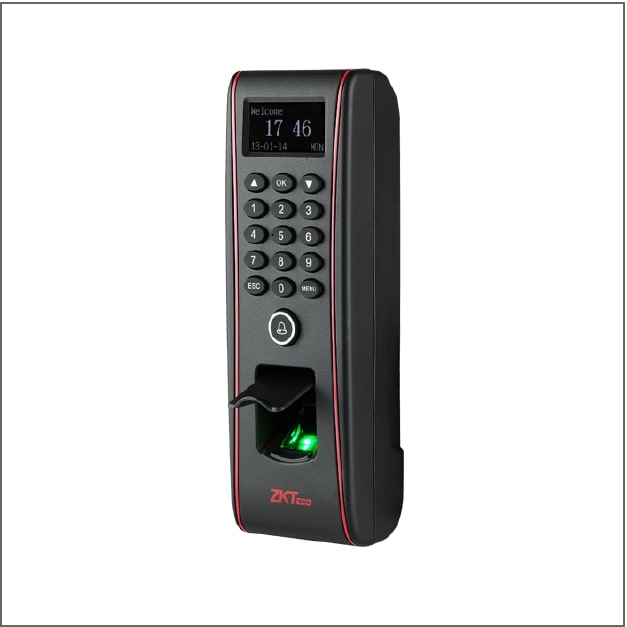Biometric Access Control System
Experience cutting-edge security with our Biometric Access Control System. This advanced technology uses unique biological traits — such as fingerprints, facial recognition, or iris patterns — to secure your door access. By replacing traditional keys and codes with precise biometric data, our system delivers high accuracy and robust protection against unauthorised access, making it an ideal choice for safeguarding your premises.

ZKBio Access IVS is a lite web-based security platform developed by ZKTeco which supports most ZKTeco Biometric Access Control System Hardware. It provides abundant functionality that full management requirements of small- to medium-sized businesses: Personnel Management, Access Control, Attendance Management, Video Surveillance, System Management.
Features
• Web-Based Attendance Module
• Supports T&A devices using the New Platform Core Board with ADMS function
• Supports setup of attendance points on A&C devices and video cameras to generate T&A logs
• Reliable Video Management System module
• Supports basic video surveillance functions, including real-time live view, playback, video recording, remote searching, etc.
• Supports facial recognition NVR to realize intelligent recognition functions
• Supports English/ Spanish/ Thai/ Indonesian/ Vietnamese/ Traditional Chinese and Simplified Chinese
• Supports language switching in real-time
• Supports self-registration of temporary staff with QR codes
• Supports HTTPS protocol for data security
• Stable, fast and consistent communication
• Reliable access control logic
• Automatic data backup
• Alarms and events email notification
• Available to upgrade to standard ZKBioSecurity software
System Topology
Gain a clear understanding of how our advanced biometric systems and devices interconnect with this system topology. This layout showcases the seamless integration of key components, including network switches, standalone access control units, and facial recognition NVRs, to secure door access and manage authentication efficiently. By mapping out the system’s architecture, you can optimise performance and strengthen security across your premises.

Facial Access Control System
Facial recognition technology is a biometric system that uses artificial intelligence algorithms to identify a person based on their facial features. Facial access control systems use this technology to grant or deny access to a physical or virtual space based on the person’s identity.
In a facial access control system, a camera captures an image or video of a person’s face and compares it to a database of authorized individuals. If a match is found, the system grants access; if not, access is denied.
Facial access control systems are commonly used for security purposes in facilities like banks, government buildings, and airports, and can also be used for other applications like time and attendance tracking or personal device unlocking.
It is important to note that facial recognition technology can raise privacy and civil rights concerns, and the use of facial access control systems is sometimes controversial.
Advantage of Biometric Access Control System
Biometric access control systems are considered to be better than traditional access control systems, such as keycard or password-based systems, for several reasons:
- Improved security: Biometric access control systems use unique and unchanging physical or behavioral characteristics, such as a person’s face or fingerprint, to grant access to a building or area. This makes it more difficult for unauthorized individuals to gain access and reduces the risk of security breaches.
- Convenience: Biometric access control systems do not require users to remember a password or carry a keycard, making it easier for them to access a building or area.
- Reduced fraud: Biometric access control systems reduce the risk of identity fraud by ensuring that only the authorized person can gain access to a building or area.
- Integration: Biometric access control systems can be integrated with other security systems, such as video surveillance systems and intrusion detection systems, to provide a comprehensive security solution.
- Improved accuracy: Biometric access control systems use advanced technologies, such as facial recognition and iris scanning, to accurately identify individuals and grant access. This reduces the risk of false rejections or false acceptances, which can occur with traditional access control systems.
Related Products
Innovative Biometric Door Access System Features for Enhanced Security

The biometric door access system is a professional door access system in Singapore design for small to medium-size businesses. It is integrated with face, fingerprint, card and password identification. This also come with a time attendance function. Biometric access control system offers unparalleled performance by using an advanced algorithm for reliability, precision and excellent matching speed. Fastest commercial-based fingerprint matching algorithm and ZK high-performance, high-image quality infrared detection fingerprint sensor. The device offers flexibility to be installed standalone or with any third party access control panels that support standard Wiegand signal. All the operations can be done on the TFT-LCD colour screen. The communication function is suitable for various environments. It can support USB download, Ethernet Network and RS485/232. The system also comes with access and attendance management software. This software is suitable as an office door access system for small and medium businesses application. The software can simultaneously manage access control and generate attendance reports.
Frequently Asked Questions
What is a biometric door access system?
A biometric door access system uses biological characteristics like fingerprints or facial recognition to grant access, enhancing security by allowing only authorised users to enter.
What are the main features of a biometric door access system?
The key features of a biometric door access system include high accuracy, convenience, enhanced security, audit trails, multi-factor authentication, and integration with existing security systems.
Are biometric door access systems secure?
Yes, biometric door access systems offer higher security than traditional methods. The unique biological traits of each individual are difficult to replicate, which reduces the risk of unauthorised access.
What happens if the biometric system fails or there is a power outage?
Most systems have fail-safes like battery backups, alternate access methods (e.g. PIN codes or access cards), and manual overrides for emergencies.
Can biometric door access systems be integrated with other security systems?
Yes, they can be integrated with CCTV cameras, alarm systems, and building management systems for comprehensive security monitoring and control.


















